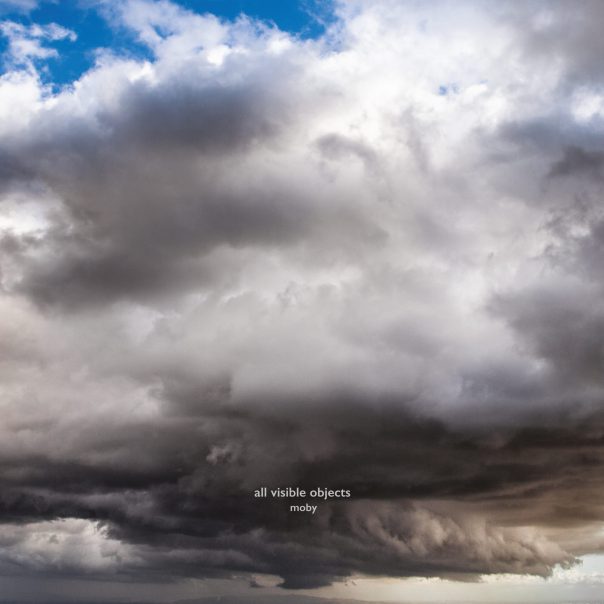ALBUM REVIEW: Moby’s ‘All Visible Objects’ is a satisfying throwback with a confusing ending

Moby, “All Visible Objects.”
Most of All Visible Objects, the new album by Moby, is a very good throwback electronic dance album. The rest is a maudlin EP of similar-sounding piano ballads. Released separately, they would each be a success for their respective audiences. Unfortunately, mashed together into one album, each undercuts the strengths of the other and the whole is less than the sum of its parts.
All Visible Objects
Moby
Mute, May 15
Compared to the final, slower, piano-driven tracks, the more traditionally Moby electronic tracks feel dated and frivolous. And compared to the energetic dance tracks, the four songs at the end of the album seem downright boring. Which is a shame because each individual song, without the context of the rest of the album, is good.
Many choose music based on what they want their mood to be—for example, they may seek out a throwback electronic dance album to raise their spirits in a dark time. But for them, slamming unexpectedly into a solid wall of ennui after eight uptempo, high-energy songs is a bait-and-switch bordering on cruel.
Even more puzzling is that the title track is itself one of the inconsistencies. If those final songs were unrelated works tacked on to compensate for the almost-overnight shift in the world’s tone and mood, it would be a more forgivable mistake, but apparently the aural whiplash was by design.
Structural issues aside, it’s only fair to judge each segment of the album separately, since there’s no reason why people can’t listen to them as such.
The opening track, “Morningside,” immediately throws you into the sort of driving beat and reverb-heavy vocal loop that defined techno in the ’90s, before it changed its name to EDM. It’s nostalgic without feeling too dated, despite some bits of digital percussion that haven’t gotten much use in the past decade. That is not an easy balancing act to pull off.
Following that are several slower tracks, but still with the underlying techno fundamentals. “My Only Love,” is similarly retro but with the piano loops and female vocals that served as Moby’s signature during his heyday. It also strikes a balance, but this time between dance track and love ballad. “Refuge” has a looped vocal, and “One Last Time” is in the same style as “Morningside” but slower.
From there, the first, pre-pandemic single “Power Is Taken” ramps up the tempo even more with a sharper beat. It sounds like it could have been on that 1994 “Mortal-Kombat”-inspired album that everyone knows but nobody can remember owning. Which is a compliment since, after all, more than 25 years later, most of a generation still remembers that album.
Finally, the last two songs of the album proper, “Rise Up In Love” and “Forever,” dip back into the formula of “My Only Love” with a decent amount of success. It slows the tempo a bit, possibly in an effort to prepare for what’s to come, but not to the necessary extent, and not to the level needed to make it feel consistent.
Then, after giving yourself a chance to stop and mentally reset, we move on to the melancholy portion of the program.
“There’s Too Much Change” is an odd choice for a single regardless of era or intent. Even aside from the other issues, it’s nearly 10 minutes long, far more than anyone other than prog rock fans will usually tolerate. Even its internal tonal consistency is all over the place, with a proper techno beat breaking in over seven minutes into the song, well after casual Moby fans have tuned out.
And even for fans of long songs, “There’s Too Much Change” just feels long. It’s a lot of song. It would be a lot for two songs.
The other two pure piano ballads, “Separation” and the title track “All Visible Objects,” begin almost indistinguishably with drawn-out piano solos. “Separation” continues along those lines, however, while “All Visible Objects” transitions into an ambient, atmospheric and instrumental meditation.
Between those two is “Tecie” which, by all accounts, belongs earlier in the album. It would have made a far better transition to those three outliers, in fact, but instead is right in the middle, adding to the tonal inconsistency.
In short, if you’re a Moby fan but not to the extent you can name all his albums in order, the first seven songs on All Visible Objects will take you back to younger, more innocent days, and maybe take your mind off the chaos in the world. If you appreciate slow, methodical piano music, and you’re looking for music to match these times, the last four songs will do that job fantastically.
Just don’t listen to the entire album in order.
Follow publisher Daniel J. Willis at Twitter.com/BayAreaData.
